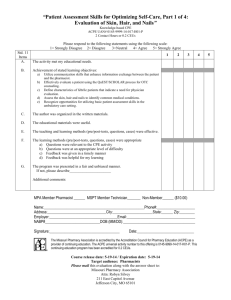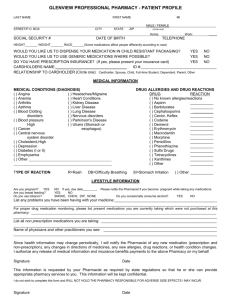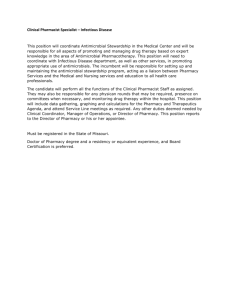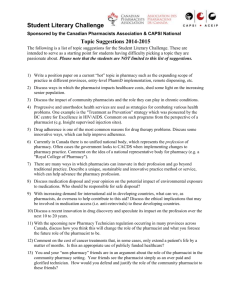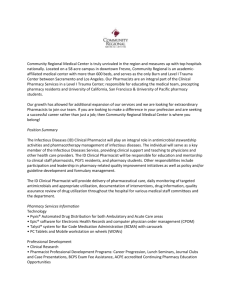Ohio Northern University The Raabe College of Pharmacy Ability
advertisement
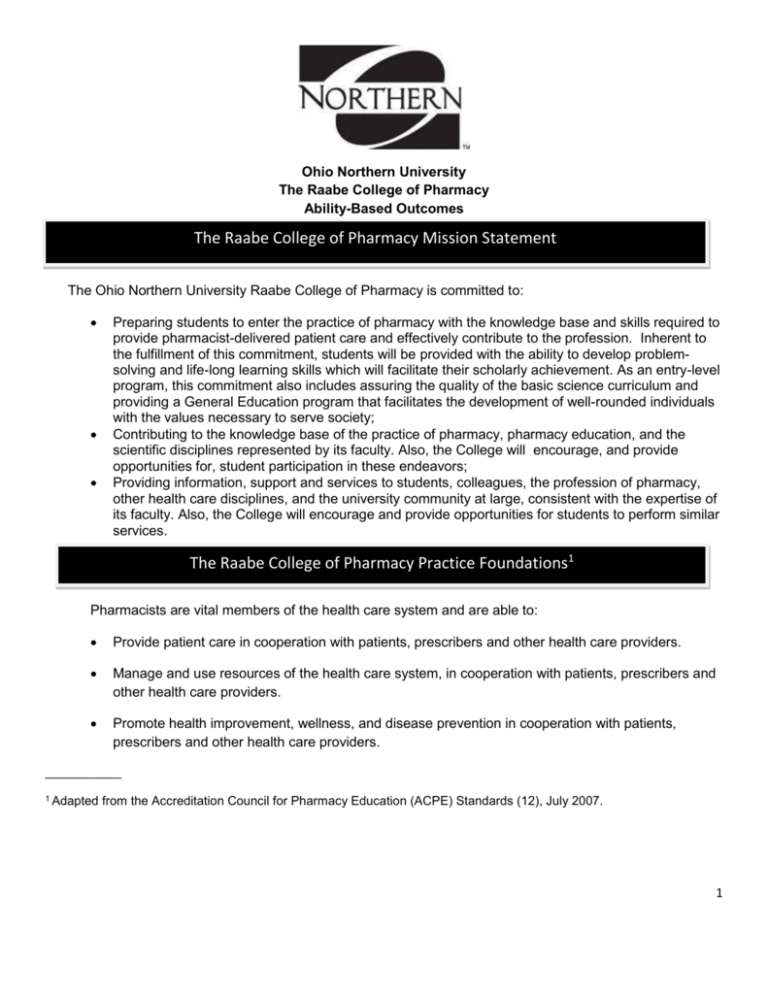
Ohio Northern University The Raabe College of Pharmacy Ability-Based Outcomes The Raabe College of Pharmacy Mission Statement The Ohio Northern University Raabe College of Pharmacy is committed to: Preparing students to enter the practice of pharmacy with the knowledge base and skills required to provide pharmacist-delivered patient care and effectively contribute to the profession. Inherent to the fulfillment of this commitment, students will be provided with the ability to develop problemsolving and life-long learning skills which will facilitate their scholarly achievement. As an entry-level program, this commitment also includes assuring the quality of the basic science curriculum and providing a General Education program that facilitates the development of well-rounded individuals with the values necessary to serve society; Contributing to the knowledge base of the practice of pharmacy, pharmacy education, and the scientific disciplines represented by its faculty. Also, the College will encourage, and provide opportunities for, student participation in these endeavors; Providing information, support and services to students, colleagues, the profession of pharmacy, other health care disciplines, and the university community at large, consistent with the expertise of its faculty. Also, the College will encourage and provide opportunities for students to perform similar services. The Raabe College of Pharmacy Practice Foundations1 Pharmacists are vital members of the health care system and are able to: Provide patient care in cooperation with patients, prescribers and other health care providers. Manage and use resources of the health care system, in cooperation with patients, prescribers and other health care providers. Promote health improvement, wellness, and disease prevention in cooperation with patients, prescribers and other health care providers. ___________ 1 Adapted from the Accreditation Council for Pharmacy Education (ACPE) Standards (12), July 2007. 1 The Raabe College of Pharmacy General Ability Based Outcomes2,3 1. Conceptual Competence: The ONU pharmacist shall understand the foundations of the pharmacy profession and its position in health care. 2. Scientific Comprehension: The ONU pharmacist shall comprehend the scientific method and its use in scientific discoveries. 3. Mathematical Competence: The ONU pharmacist shall use mathematical variables to analyze physical, chemical, biological and socioeconomic phenomena. 4. Communication Competence: The ONU pharmacist shall appropriately inform, educate and motivate using a variety of methods and media with clarity, sensitivity, and accuracy. 5. Critical thinking and decision making abilities: The ONU pharmacist shall acquire, evaluate, synthesize and apply information, knowledge and processes relevant to the solution of an identified problem and make sound decisions. 6. Social Awareness: The ONU pharmacist shall demonstrate the ability to place health care and professional issues within appropriate historical, cultural, social, economic, scientific, political and philosophical frameworks, and demonstrate sensitivity and tolerance within a culturally diverse society. 7. Professional Conduct and Demeanor: The ONU pharmacist acts ethically and responsibly, with integrity, compassion, empathy, and respect. Our pharmacist accurately self-assesses behaviors and conduct, and seeks, accepts and applies constructive feedback. 8. Leadership, Innovation and Advocacy: The ONU pharmacist initiates or contributes to positive change on behalf of patients and the profession. ____________ 2Adapted fro ACPE CAPE Advisory Panel on Educational Outcomes, November 1998. 3Adapted from A Background Paper II: Entry-Level Curricular Outcomes, Curricular Content and Educational Process, American Journal of Pharmaceutical Education, 57:377-385; Winter 1993. 2 The Raabe College of Pharmacy Professional Ability Based Outcomes I. Provide patient care in cooperation with patients, prescribers and other health care providers. A. Develop and implement population-specific, evidence-based pharmaceutical care programs 1. Develop medication use criteria 2. Conduct and analyze medication use reviews 3. Identify and use risk reduction strategies 4. Interpret epidemiologic and pharmacoeconomic data relevant to specific diseases and their management B. Formulate, evaluate and implement appropriate patient or drug-related information that will generate a new or revised care plan 1. Take a patient health history, including medication history 2. Identify patient attitudes toward taking medications 3. Assess patient adherence 4. Identify adverse drug reactions 5. Identify barriers to health care for a patient 6. Determine accuracy of patient allergy 7. Evaluate laboratory test results and pharmacokinetic data 8. Retrieve, evaluate and apply current disease state information in the delivery of pharmaceutical care 9. Retrieve, evaluate and apply current drug information and evidence based medicine in the delivery of pharmaceutical care 10. Evaluate signs of potential indicators of drug misuse, abuse, therapeutic success or failure C. Work with the prescribers and other health care providers to develop and implement a patient care plan 1. Communicate clearly, accurately, and knowledgeably with patients, caregivers, prescribers and other health care providers in appropriate verbal, nonverbal and written communications. 2. Triage patients to appropriate health care providers. 3. Assess the effectiveness of health communication strategy: 3 a. Evaluate patient and caregiver understanding of the patient care plan. b. Appraise patient and caregiver skill in medical product use. c. Assess patient and caregiver participation in the patient care plan. d. Modify health communication strategy as needed. 4. Empower the patient and caregiver to be active partners in the patient care plan. 5. Provide counseling on the selection and use of non-prescription medications. 6. Monitor patient response to therapy 7. Assure safe and accurate preparation and dispensing of medications: a. Read and interpret written prescriptions b. Receive and transcribe verbal prescription orders c. Recognize when a prescription falls outside the usual dose range d. Determine whether a medication order should be filled e. Recommend a course of action when a medication order should not or cannot be filled f. Perform calculations required to compound, dispense, and administer medication g. Select medications that promote safe and effective use h. Prepare and compound extemporaneous preparations and sterile products i. Prepare, package, and label a dosage form according to state and federal laws 8. Administer immunizations D. Exhibit professional attitudes and behaviors 1. Establish and maintain covenantal relationships with patients 2. Promote the good of every patient in caring, compassionate, and confidential manner. 3. Respect the autonomy and dignity of each patient 4. Act with honesty and integrity in all professional matters 5. Demonstrate an ongoing commitment to maintaining professional competence 6. Respect the value and abilities of others 7. Serve individual, community and societal needs 8. Provide patient care in accordance with legal, ethical, social economic, and professional guidelines. 4 II. Manage and use resources of the health care system, in cooperation with patients, prescribers and other health care providers. A. Select resources that will accurately and efficiently find drug and health information. B. Identify relevant monographs through a well-designed literature search. C. Document drug information provided. D. Participate in the management and use of health care resources within health care systems. 1. Identify the key features of private and public payers of health care a. Describe benefits provided by Medicare. b. Describe the roles of state and federal governments in financing and administering Medicaid. c. Describe the objectives of health insurance and managed health care programs. d. Differentiate between insuring health and managing health care. 2. Define the role of the pharmacist in providing medication therapy management. III. Promote health improvement, wellness, and disease prevention in cooperation with patients, prescribers and other health care providers. A. Define and assess the health status of individuals and populations, including determinants of health and illness, factors contributing to health promotion and disease prevention, factors influencing the use of health services, and epidemiology of diseases. B. Formulate and implement strategies to promote healthy lifestyles and programs for preventive health care and disease detection. 1. Define the role of pharmacists in addressing public health issues. 2. Anticipate and consider social, economic, and cultural issues. 3. Provide public health-related services and educational material tailored to the needs of patients, caregivers, and other health care providers. C. Promote a healthy lifestyle, including the appropriate use of screening tools and immunizations. 5

